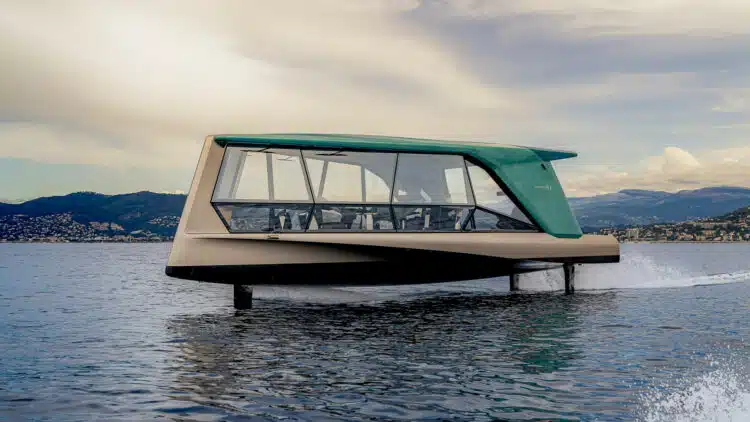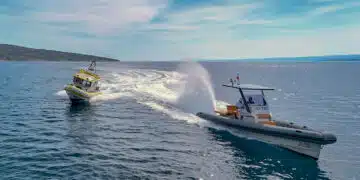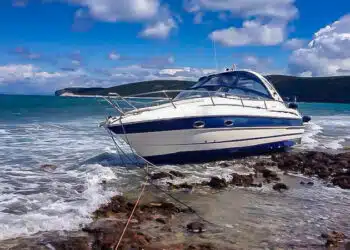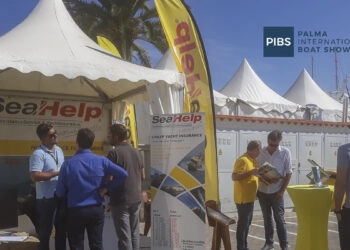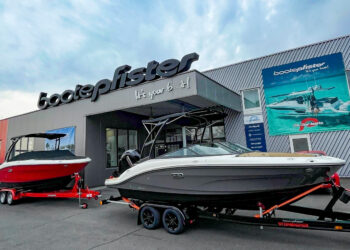The future on the water is electric. After the electric motor of the new Porsche Macan was recently implanted in a Frauscher 850 Fantom Air for the first time, BMW recently presented its new electric boat THE ICON in Cannes, which runs on its own battery packs and a drive from Torqeedo. The special feature of this futuristic-looking boat is that it is a foiler. SeaHelp will be presenting interesting, forward-looking projects in the field of alternative drives and e-mobility on the water here at irregular intervals.</strong
The future on the water is electric – there’s no doubt about that. We present new, innovative projects dedicated to alternative drives and e-drives on boats in loose succession (see our news on ed-tec by the former chief strategist at VW, Michael Jost, and on the H2C-Boat, which has a Fuel-Cell on board, to the new Porsche boat and to the new E-outboard from Mercury).
There is currently a new era on the water when it comes to new, alternative drives: while companies have recently adorned themselves with electrically powered boats in order to greenwash their brand (such as the diesel giant Deutz with the start-up Torqeedo – albeit with dubious success, as reported by Manager magazine in its latest issue 11/23), several serious projects in the field of powerful, exclusive boats became reality this fall.
The presentation of the new, 8.67-metre-long and 2.49-metre-wide Porsche sports boat (draught with trim down: 0.9 meters) was a real sensation. The Frauscher x Porsche 850 Fantom Air is powered by the electric motor of the new Porsche Macan SUV, which will not be officially unveiled until next spring.
The name of the futuristic-looking BMW boat: THE ICON
The next spectacular presentation in the field of alternative drives and e-mobility on the water followed in Cannes. The name of the futuristic-looking boat, which was jointly developed by car manufacturer BMW and the start-up led by former Torqeedo boss Christoph Ballin: THE ICON.

Following a trend in the industry, BMW now also has its own boat. According to the Munich-based car manufacturer, with THE ICON it is presenting “a vehicle for emission-free mobility on water”, which “stands for a holistically conceived ecosystem” that redefines emission-free mobility and now also includes transportation on water in addition to road traffic.
Because, the car manufacturer continues: “urban areas in particular need new and more sustainable solutions” that are relevant for the people who live there. The boat manufacturer Tyde, a start-up founded by Torqeedo founder and (former) CEO Christoph Ballin, was responsible for the development and implementation of THE ICON. The design of the innovative watercraft was created in the studio of BMW Group subsidiary Designworks.
The ICON combines BMWi’s many years of experience in the field of electromobility with the expertise of boat manufacturer Tyde
BMW used the transfer of existing technologies and knowledge to create a “holistic solution for sustainable premium mobility in the urban environment”, according to BMW. The BMWi brand’s many years of experience in the field of electromobility have been combined with the expertise of boat manufacturer Tyde in THE ICON project. With its forward-looking design and locally emission-free drive, THE ICON also stands for a progressive interpretation of luxury in the form of responsible enjoyment.
THE ICON made its first appearance at the Cannes Film Festival in May. The e-boat was then presented to the water sports and yachting scene at the Cannes Yachting Festival, the Monaco Yacht Show and Les Voiles de Saint-Tropez. SeaHelp went on board in Cannes and drove the futuristic-looking boat.
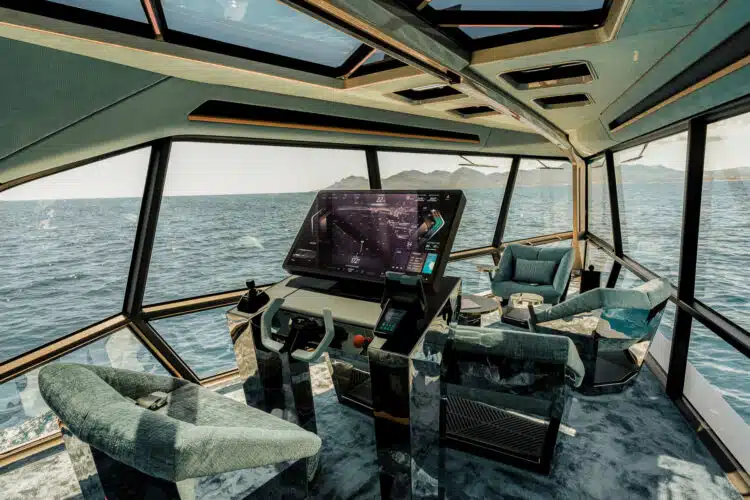
THE ICON sets new standards in several respects with its battery-electric drive
With a length of 13.15 meters and a top speed of 30 knots (55.5 km/h, according to the shipyard), THE ICON claims to be “the pioneer of a new type of watercraft with battery-electric propulsion”. “Conceived by BMW and designed by Designworks, a subsidiary of the BMW Group with studios in Los Angeles, Munich and Shanghai, the development and implementation of this unique concept was entirely in our hands,” says Christoph Ballin, Managing Director of yacht manufacturer Tyde.
With its battery-electric drive, THE ICON sets new standards in the competitive environment in several respects. Until now, maritime electromobility has been limited to smaller, slower vehicles with a comparatively short range. The segment of larger and faster boats with a longer range, on the other hand, has so far been 100% dominated by models with “classic” combustion engines.
Underwater wings, known as hydrofoils, reduce energy requirements by up to 80 percent compared to a conventional hull
“THE ICON redefines the relationship between the dimensions of size, top speed and range of an electrically powered watercraft,” says Christoph Ballin confidently during the test drive. This is made possible by an innovation from the world of sailing: underwater wings, so-called hydrofoils (known from the America’s Cup, for example), reduce energy requirements by up to 80 percent compared to a conventional hull.
The ingenious foiling technology, in which the vehicle rests on wings below the water level while the hull floats above the water surface, also makes for a more comfortable ride and a higher speed, says Ballin.
Two 100 kW electric motors from Torqeedo’s Deep Blue series convert the energy content of 240 kWh from six batteries (produced by BMW) into a range of over 50 nautical miles (100 kilometers) at a speed of 24 knots (44.5 km/h).
Despite waves, THE ICON glided through the water almost silently and vibration-free during our test off Cannes
With its innovative drive from Torqeedo and thanks to foiling technology, in which thousands of computer-controlled calculations per millisecond in combination with dozens of sensors always calculate the optimum angle of attack of the underwater wings, THE ICON actually enables almost silent gliding without vibrations during our test off Cannes, even though there were 20-30 centimeter high waves on the day of our sea trial.
The low design and the generous proportions of the hull – in relation to the length of the boat – allow the luxurious-looking interior to be used across almost the entire width of 4.5 meters. The central spine, which protrudes from both sides of the hull and forms the backbone of the watercraft, houses the technical components such as modern LED light strips at the bow and stern as well as the charging connection points.
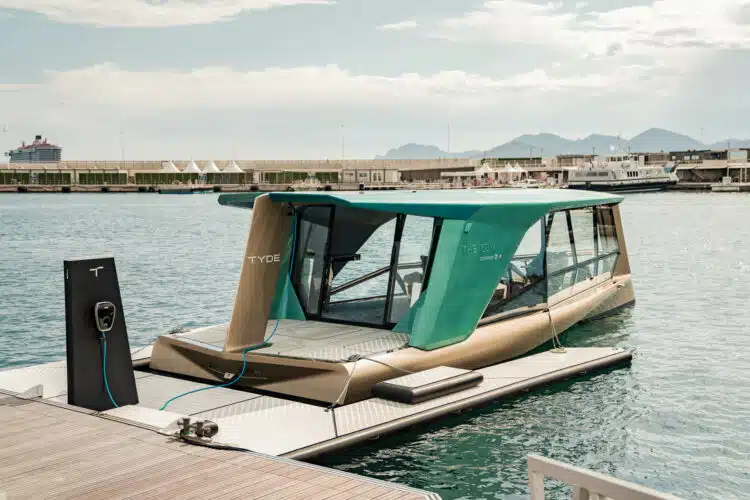
The body has a lightweight origami structure and there is standing height for passengers throughout the interior. “Generous glass walls offer passengers a generous view as they glide over the water and enjoy the luxurious ambience on board,” says Christoph Ballin.
Docking and casting off maneuvers are difficult, and there is no toilet on board
So far, so good. However, we wonder who exactly the target group of this boat is supposed to be – managers of large companies who need to be shuttled quickly from Cannes to Monaco or out to a superyacht?
In that case, however, the journey should not take too long, as THE ICON has no sanitary facilities whatsoever. And: when mooring and casting off from the jetty, a second helping hand is always needed to attach or detach the lines at the bow, as there is no way for the skipper, guests or crew to access the foredeck, either from inside or “outside”.
Nevertheless, THE ICON’s combination with foils should really set new standards in terms of top speed (in relation to boat weight and length) and range of an electric boat. Who knows – perhaps what today still seems like an unfamiliar future project that has just become reality will be part of everyday life in a few years’ time?
Hard to imagine today, but quite likely. BMW and Tyde definitely have their “foot in the door” here and have secured a good starting position for the market of the emission-free future on water thanks to their technical and time lead in the development and presentation of a corresponding prototype.
Further information: tyde.one
Technical specifications:
Overall length: 13.15 m
Length waterline: 12.95 m
Width: 4.50 m
Displacement: 10 – 11 t
Draught as displacer / with foils: 1.87 / 0.85 m
Passengers: 8
Main drive: 2 x 100 kW electric motors from Torqeedo (Deep Blue 100i)
Battery capacity: 240 kWh
Maximum speed: 30 kn / 55.5 km/h
Maximum range: 50 nm at 24 kn speed (92 km at 44.5 km/h)


